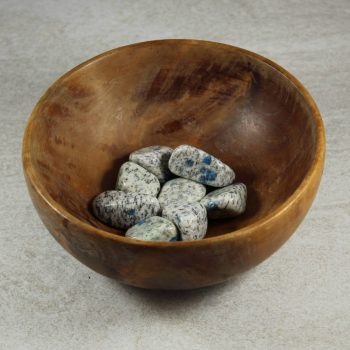K2 Stone
K2 stone is an unusual beast. It is often missold as Jasper or given various other names, but analysis has shown it to be blue Azurite in Granite.
It mostly occurs around K2 in Pakistan – hence the name! K2 stone is almost always sold polished – it is relatively unimpressive as a rough mineral specimen but looks rather nice polished.
Showing the single result
Appearance, Uses and History
K2 Stone is an unusual type of stone which has caused a lot of debate over the years!
It is often sold as “K2 Granite”, or “K2 Jasper”, but the true composition is likely beyond the knowledge of many. It is, however, definitely not a form of Jasper; this is a trade name only and should not be used.
To put it as simply as I can, this is a Granite with splotches of Azurite, which is unusual as the two do not normally occur together. There is a little more detail below, and significantly more detail in the links at the bottom of the page for further reading.
K2 Stone is quite a new one to the market, and is exclusively used as a decorative object. As the entire point of its appeal is the blue patches, it is somewhat limited in how it could be worked – tumblestones, small cabochons, beads, etc may be too small to have many, if any patches of blue on.
It is possible, although not personally confirmed by me, that sellers could dye patches of a granitic rock with blue dyes to simulate this stone. Test with Acetone or another solvent if in doubt.
Locales
Kind of unknown, actually! The material is definitely mined in Pakistan; it may be somewhere in the Karakoram mountain range which it takes its name (K2) from. Other sources claim it is from closer to Skardu.
The exact location remains somewhat of a mystery publicly. I would suggest it is not quite as close to the mountains as some claim – it would be very difficult to make it economically viable to remove any material.
Mineralogy
The Azurite is a secondary mineral which formed after the rest and acts almost as a dye, staining the granite. In some cases there are green rings around the blue patches; assumed to be Malachite.
Hazards and Warnings
Almost all rocks, minerals (and, frankly, almost all other substances on earth) can produce toxic dust when cutting, which can cause serious respiratory conditions including silicosis.
When cutting or polishing rocks, minerals, shells, etc, all work should be done wet to minimise the dust, and a suitable respirator or extraction system should be used.
K2 Stone is a trade name aimed at the English speaking market and would not translate well, so we have included translations for “Granite with Azurite”.
Translations
Arabic:
- الجرانيت مع أزوريت
Hindi:
Portuguese:
- granito com azurita
Bengali:
- আজুরাইট সহ গ্রানাইট
Indonesian:
- granit dengan azurite
Punjabi:
- ਅਜ਼ੂਰੀ ਨਾਲ ਗ੍ਰੇਨਾਈਟ
English:
- K2 Stone
- ‘K2 Jasper’ (incorrect, misleading trade name)
- Granite with Azurite
Italian:
- granito con azzurrite
Russian:
- гранит с азуритом
French:
- granit avec azurite
Japanese:
- K2ストーン
- アズライトと花崗岩
Spanish:
- granito con azurita
German:
- Granit mit Azurit
Korean:
- 남동석과 화강암
Thai:
Gujurati:
Mandarin and Traditional Chinese:
- 蓝铜矿花岗岩
- 藍銅礦花崗岩
Urdu:
Further Reading / External Links
Most of these links reference the Mindat thread, which is one of the only sources of good information on this material.
- https://geology.com/gemstones/k2/
- https://www.linkedin.com/pulse/k2-jasper-unconventional-gemstone-kathleen-marino-g-g-/
- https://www.mindat.org/mesg-304299.html
- http://www.thepracticalgemologist.com/gemstones-2/2015/5/22/pick-of-the-week-nicholas-varnay-and-k2
- https://the-earth-story.com/post/177199402621/the-k2-granite-ive-been-writing-here-for

